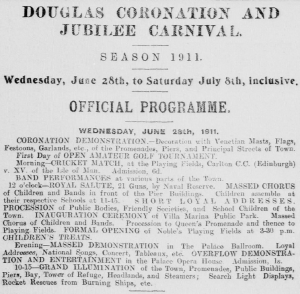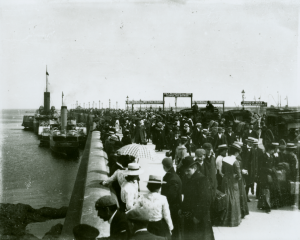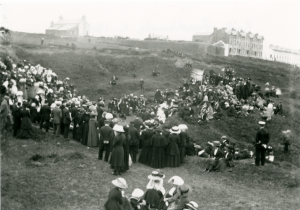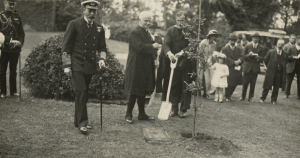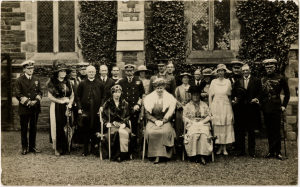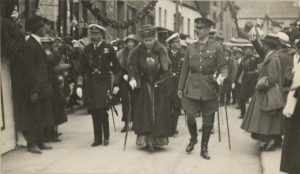George V’s Coronation Day in the Isle of Man (22 June 1911)
King George V and Queen Mary were crowned at Westminster Abbey on 22 June 1911.
Peel City Guardian, 24 June 1911, p.17
The Lieutenant Governor of the Isle of Man Lord Raglan proclaimed Coronation Day a Bank Holiday and like most bank holidays,
“Coronation Day broke grey and unpromising in weather.” (Mona’s Herald, 28 June 1911, p.4)
It wasn’t only the weather which Mona’s Herald considered to put a dampener on the occasion. The Douglas Municipal Jubilee ten-day carnival was in full-swing and threatened to steal the limelight from a Coronation happening miles away in London. Fortunately, Strand Street put on a colourful show,
“Only one street combined for effective display. This was our oldest and chief business thoroughfare – Strand Street. The narrow old way, with its strange mixtures of new and old, high and low architectures, lends itself to decoration with bunting and flags; and in its perspective ending in an apparent point, the vista under the thousands of vari-coloured flags, banners, festoons, and garlands, parallel and cross-wise, stirred the charm of all beholders, whatever their age.” (Mona’s Herald, 28 June 1911, p.4)
Mona’s Herald, 28 June 1911, p.5
In comparison a nearby thoroughfare ought, in the newspaper’s opinion, to blush for want of effort,
“it must be said that Victoria Street, as the chief artery, was wholly unworthy of itself. In general, the attempts at ornamentation were tawdry, if not cheap and nasty; and there was a made-in-Germany look in their run colours after the light rainfall on Wednesday evening…The corner front of the Villiers Hotel was fairly gay, but over its other vast frontages the decorations were sparse. The other hotels made no pretence with scheme of decoration; a few flags and an emblem here and there, told that they knew the day; if they did not rise to it.” (Mona’s Herald, 28 June 1911, p.4)
Mona’s Herald was equally scathing about the lack of an official Coronation Day church service in Douglas. The “as-you-please services” in all the churches was “condemned in the smallness of the attendances and the parochial air that was over what should have been a glad and general thanksgiving”(Mona’s Herald, 28 June 1911, p.4). Tawdry bunting and empty pews were nothing however to the near calamity that evening which took place on Douglas Promenade thanks to half-a-dozen rockets and a crowded pier,
“Three big Coronation bonfires were lit on the stroke of ten [that] evening. They took their instant time from a couple of rockets fired from the Victoria Pier by some members of the Rocket Corps. We witnessed the signalling, and its elements of a disaster. Good luck, more than good management saved the people, who were in an indiscriminate group beside the official signallers. First, a half-dozen rockets were brought on to the scene. Instantly the bearers of them were grouped round by a wonder-making people at the other end of the pier shelter. There for a time the rockets passed from hand to hand, and one man whose name was —-, and who was strongly under the influence of drink, had the holding of several of them. The risk was commented on. Then the rocketiers went across to the north side of the pier, and without any precaution to keep back the pubic, the rockets were set off. The first made a rocketting ascent to the admiration of the bystanders. The second took a turn inland directly it fired, and but that its course was a few feet outside the parapet of the pier, a number of those around might have been killed or maimed. But without ado, the third rocket was fired after the same irresponsible manner, and happily went aloft.” (Mona’s Herald, 28 June 1911, p.4)
Crowds on Victoria Pier, Douglas © Manx National Heritage (PG/5845/19)
Happily too the ‘old folks’ treat’ earlier that day at Murray’s Road Board School was better organised with transport of all kinds used to get the feast to over 600 old folk. Each meal ticket came with another ticket “to travel to and from the school by the cable and horse tramways”,”
“It was pleasing to see many of the old folk, who were thus riding for the first time in the municipal carriages, assume the dignified airs of lords and ladies. The table array which met their eyes on entering the school made radiant their faces. Great piles of sliced rounds of beef, chops of lamb, mountains of cake, smoking dishes of mealy potatoes, and green peas; condiments of which mint sauce was the prime mouth waterer; great dishes of pastry and fruit; and an array of glasses which indicated an ad lib supply of mineral waters or the genuine nut brown for a wash-down.” (Mona’s Herald, 28 June 1911, p.4)
A lorry was driven to the homes of around 80 feeble guests, preceded by town nurses in a car, who dispensed “a travelling feast of hot tea, lamb, and beef, cakes, and fruit” (Mona’s Herald, 28 June 1911, p.4). During the meal a telegram was dispatched to the King and Queen which said, “Six hundred old folk, celebrating your Majesties’ Coronation at Douglas, wish you long and happy reign.” Reply was received before the evening was over, the King thanking them all for their “loyal sentiments” and, though unspoken, full bellies enjoyed in honour of his Coronation,
“The feast was without stint. It was eat and come again.” (Mona’s Herald, 28 June 1911, p.4)
In Onchan meanwhile “tobacco was given to the aged men, and groceries to the aged women” (Mona’s Herald, 28 June 1911, p.4) and “with an eye on the sky” the “tea and cake fray” was moved from Howstrake Orchard to the Board School. The rainy weather this day in June played a lead role in Coronation programmes across the island. At Peel Castle during their Coronation celebrations the Three-legged Race, Frog Race and Flower Pot Race were all run in the rain and children and adults, unprepared, “were drenched on their way home” (Peel City Guardian, 24 June 1911, p.8). More tragedy,
“A fancy dress carnival was to have been held, but the heavy rain continued and this could not take place. There were over ninety entries for this. In spite of the rain over thirty competitors trudged up to the meeting place, only to be disappointed. It is a great pity the carnival could not take place, as the costumes and the decorated bicycles were really fine.” (Peel City Guardian, 24 June 1911, p.8)
Despite the downpour the Boy Scouts and their “untiring efforts in the procession” with drum and bugle and the ceremony to plant the Coronation Oak in the Market place kept spirits high, as did the “profusion of bunting” on the Viking House and the Railway Hotel and the “royal salute of twenty one rifle volleys” (Peel City Guardian, 24 June 1911, p.8). T.H. Cormode, MHK, at the service in the hollow facing the Promenade, addressed Peel townsfolk and asked a question we might well ask now,
” ‘The fact that you have sunk all differences for the time being and united in this service is significant. It proves for one thing, I take it, that you desire not only as individuals, but as a town, to display your loyalty to the throne…if I rightly interpret your feelings…what do we expect a King to fulfil in such times as these?’ ” (Peel City Guardian, 24 June 1911, p.8)
Cormode continued his lengthy speech praising the “spiritual force” of Queen Victoria and the “public charity” and peace-maker tendencies of Edward VII, mindful, as indeed were many in his audience, of Coronation Days past,
” That George V will worthily maintain the great traditions which he has inherited, and even add new lustre to the crown placed on his brow today, is not only our hope ad prayer but also our confident belief…a coronation is a hallowing, a consecration, and as such was unquestionably regarded by Queen Victoria and Edward VII, and there can be little doubt it is regarded in the same spirit by King George and Queen Mary. And I imagine that when the solemn ceremony of consecration was being performed today the spirits of Albert the Good and Victoria the Good and Edward the Peacemaker hovered near…’ ” (Peel City Guardian, 24 June 1911, p.8)
Crowd on Peel headlands on the Coronation of George V © Manx National Heritage (PG/2155) Ramsey and the North ultimately wore the crown in the Isle of Man that Coronation Day,
“As for Thursday’s joyous festivals, they were celebrated with that heartiness and goodwill for which Ramsey and the North are conspicuous.” (Ramsey Courier, 23 June 1911, p.5)
In the parish of Andreas, despite the heavy rain and the “stampede for shelter”, novelist Hall Caine donated 21s for the Coronation festivities, the children “were liberally regaled with nuts and sweets…and oranges”, and need we never forget “the tea makers (Mrs Goldsmith and Mrs Sayle)” who “did their work well, and were complimented on the excellence of their ‘brew’.” (Ramsey Courier, 23 June 1911, p.5).
“Bunting and flags, gay and variegated, bright and beautiful” were everywhere in Ramsey including in harbour on the “gaily bedecked” shipping (Ramsey Courier, 23 June 1911, p.5). Impromptu poles and flag staffs and the mottoes ‘God bless the King’ and ‘God save the Queen’ fluttered down Parliament Street. At St Paul’s Church a large congregation imagined itself transported to Westminster Abbey as The Revd Wodehouse, “in clear and impressive voice” recited the identical “solemn sentences of the great ceremonial” (Ramsey Courier, 23 June 1911, p.5). At 12 noon a Royal salute of 21 guns was fired from opposite the Rocket Station. The programme – itself “a souvenir, with deep red covering, amply illustrated on the front page with portraits in miniature of the King and Queen, and those of prominent public gentlemen in the inner pages” (Ramsey Courier, 23 June 1911, p.5) – began with the High-Bailiff, Mr Cruickshank, addressing a crowd of several thousand gathered at the Town Offices,
” ‘The Town Clerk, in arranging the programme, was good enough to put me down for an address on loyalty, etc. I do not know what the Clerk had in his mind as to the etc. But I entirely repudiate the idea of attempting to enlarge upon such a subject to an adult Manx audience. Manx people are so essentially loyal that I am sure they would resent any attempt to preach to them upon such a subject.’ ” (Ramsey Courier, 23 June 1911, p.5)
Loyal crowd acknowledged it was time for the procession with the Boy Scouts in the vanguard. “The Scouts went off at a smart pace, accompanied by the martial strains of their trumpeters, and throughout the day they gave a spirited tone to the proceedings” (Ramsey Courier, 23 June 1911, p.5). The Sunday Schools and Friendly Societies followed, including the Foresters who, incongruously, “had many mounted men in the garb of the valiant Robin Hood” (Ramsey Courier, 23 June 1911, p.5). The procession, which delighted the long line of spectators who thronged the route, made its way from the Market, along the East Quay, up the Promenade and Ballure Road, down Waterloo Road, Parliament Street, East Street, Swing Bridge, Mooragh, Bowring Road, and thence to Parliament Square.
Time on Coronation Day in Ramsey was marked also by the unveiling of the new Town Clock. It was “the most practical and permanent commemoration of Coronation Year” as Mr Moysey (Chairman of the Town Board) “deftly manipulated the cords suspending the flag, which covered the face of the clock, and thus formally unveiled it, amid cheers, beating of drums, and a fanfare of trumpets” (Ramsey Courier, 23 June 1911, p.5). A Coronation is a mark of the passing of time not only for monarchs but for nations and the folks that witness them. The “never-weary teachers” in Ramsey served the children, “with appetites sharpened by the parade”, scones, Scotch buns and bunloaf. Afterwards, the schools reassembled on the Market Place and nearly 1,200 souvenir medals were distributed including to “tiny mites of but a few weeks old, brought in their mother’s arms to get the pretty souvenirs which were done up neatly with red, white and blue bows” (Ramsey Courier, 23 June 1911, p.5).
Ramsey and the North boasted loyal celebrants, young and old, that Coronation Day,
“In some of the remote Northern regions there are elderly people who have long exceeded the alloted span, yet who remember with pride, the Coronation of the Great Queen Victoria, also the landing on our shores of that illustrious lady and Prince Albert, in commemoration of which the prominent Tower is a standing monument. Again, that ever-memorable visit of King Edward and Queen Alexandra in 1902 is still fresh in the minds of people, and is proclaimed by a bronze tablet on the Queen’s Pier, which denotes their Majesties landing there from the Royal yacht Victoria and Albert” (Ramsey Courier, 23 June 1911, p.5).
It was remarkable that two old gentlemen of the north, both born during the reign of George III, had lived under six different Sovereigns, George III, George IV, William IV, Queen Victoria, Edward VII, and now George V. William Corlett, aged 97, and Edward Collins, 96, were the unofficial guests of honour at the ‘Old Folks’ Treat’ having earlier that day been been part of the procession as ‘Coronation Day veterans’ seated on Mr Chrystal’s pony and trap,
“The gig bore a neat card upon which was inscribed, ‘Ramsey’s Oldest Veterans Honour their King.’ The aged subjects of his Majesty were everywhere received with acclamation and delight, and it was evident that they immensely enjoyed the memorable day and the reception accorded them” (Ramsey Courier, 23 June 1911, p.5).
Postscript. King George V and Queen Mary visited the Isle of Man in July 1920. Below is a selection of photographs taken from the Manx National Heritage Library and Archives of their visit.
© Manx National Heritage (PG/6510/2)
© Manx National Heritage (PGN 00553)
© Manx National Heritage (PG/6510/4)
© Manx National Heritage (PG/3176/5)
© Manx National Heritage (PG/6557)
George V’s Coronation Day in the Isle of Man is part of ‘Coronation Days Past in the Isle of Man’, stories re-told from the island’s historic newspapers cared for by Manx National Heritage, the charity responsible for the Isle of Man’s natural and cultural heritage.
Visit coronation.gov.im
Jude Dicken, Collections Information Manager, Manx National Heritage
Blog Archive
- Edward VII’s Coronation Day in the Isle of Man (9 August 1902)
- Victoria’s Coronation Day in the Isle of Man (28 June 1838)
- Second World War Internment Museum Collections
- First World War Internment Museum Collections
- Rushen Camp: Second World War Internment on the Isle of Man
- Hutchinson, Onchan & Peveril Camps: Second World War Internment on the Isle of Man
- Douglas Promenade: Second World War Internment on the Isle of Man
- Mooragh Camp: Second World War Internment on the Isle of Man
- Sculpture collection newly released to iMuseum
- Fishing Folklore: how to stay safe & how to be lucky at sea
- News from the gaol registers project: remembering the men and women who served time in Castle Rushen
- Explore Mann at War: stories of Manx men, women and children in conflict
- We Will Remember Them: Isle of Man Great War Roll of Honour (1914-1918)
- Dr Dave Burnett explores Manx National Heritage geology collection
- Unlocking stories from the Archives: The Transvaal Manx Association
- Login to newspapers online: step-by-step guidance
- ‘Round Mounds’ Investigation Reveals Rare Bronze Age Object


